0 Introduction
Given the fast-paced growth in renewable energy generation and electric vehicles,the associated electrical machine drive systems have drawn increasing attention [1,2].Owing to their superior speed regulation performance,ease of starting,and energy-saving capabilities,inverterfed machines have been extensively used in multiple applications [3,4].
Typical faults in electric machines can be broadly categorized into bearing-,stator-,and rotor-associated faults.Research indicates that over one-third of malfunctions in electric machines are attributable to stator-related issues [5].The insulation of the stator winding,a highly vulnerable element in the drive system,is responsible for approximately 80% of the electrical faults within the stator,primarily originating from local inter-turn insulation degradation[6].Various factors influence the degradation of electric machine insulation,and switching transient overstress has emerged as a significant cause of insulation failure in inverter-fed machines [7].Particularly noteworthy is the recent trend of wide-bandgap power devices,gradually replacing traditional silicon-based power electronic devices.This evolution results in faster switching speed/frequency and larger operating voltage,presenting greater challenges to insulation systems within electric machines.
Condition monitoring (CM) is a pivotal technology for enhancing the reliability of power devices.Current insulation CM techniques are broadly divided into two types: offline and online methods [8].The maturity of offline testing technology has been the foundation for many online monitoring approaches.Typical offline tests include offline partial discharge (PD),insulation resistance,polarization index tests [9-11],and dissipation factor and capacitance (DF/C) tests [12,13].Online insulation CM technology has gained increasing interest owing to its ability to deliver real-time information on the dielectric health status without disrupting the regular operation of the system.Impedance spectrum monitoring,surge,and insulation leakage current tests were developed for online insulation monitoring [14,15].However,most existing CM methods focus predominantly on groundwall,with limited research dedicated to the degradation of turn insulation.Surge and PD tests are the most commonly used techniques for evaluating stator turn insulation.Nevertheless,a surge test,which requires applying a significantly impulse voltage,can be destructive to the insulation of the machine.Moreover,online PD tests are susceptible to inverter electromagnetic noise,making them unsuitable for low-voltage machines.
Capacitance variation is a dependable indicator of turn insulation degradation in inverter-fed machine stator windings [16,17].However,the measurement of leakage current changes is challenged by the high impedance of insulation capacitance at low frequencies (MΩ-level),high-sensitive and costly sensor equipment is required to measure the variation in leakage current.Consequently,to enhance the responsiveness of online insulation condition surveillance,research activities have been directed toward investigating HF characteristics of the system.These efforts can be broadly categorized into two approaches:the HF injection method and the inverter switching selfexcitation method [18-20].Compared to the HF injection method,which requires an extra stimulation source and might interfere with the regular functioning of the system,the inverter switching self-excitation method employs inverter switching as the HF excitation source,thereby circumventing these limitations.Step excitation is applied to the motor winding through the controlled switching of the inverter,utilizing the resultant transient current for online insulation monitoring,thus not compromising efficiency and reliability.In reference [20],the HF characteristics of an inverter were identified using the transient current response generated by inverter switching.The findings verify that the HF information can be utilized to monitor turn insulation degradation.In reference [21],the HF oscillation current of an inverter-fed machine during the switching transient was treated as the transient resonance response of the stator winding incidental parameters,which was exploited to monitor the incipient turn insulation state through the switching transient frequency response curve.In reference[22],this study defined and validated the tail section of switching oscillation current as a characteristic indicator for monitoring the turning-insulation degradation state.
Nonetheless,when the turn insulation state gradually deteriorates,the changes in the HF switching oscillation current are minor,yielding a low resolution across time and frequency spectra.Heisenberg’s uncertainty principle asserts that achieving optimal resolution simultaneously across time and frequency spectra analyses is impossible[23].Alternatively,the fractional Fourier transform (FrFT)presents the potential to identify a superior performance fractional domain situated,enabling the pursuit of higher resolution by manipulating fractional orders [24].FrFT is now commonly applied in fields such as signal recognition and radar communication [25].
In this study,the weak response of the switching oscillation current to insulation degradation is addressed by proposing a highly sensitive state perception method for inverter-fed machine turn insulation based on FrFTMel.FrFT was first used to effectively characterize turn insulation features.An enhanced Mel filter was devised for feature extraction,grounded in the characteristics of the common-mode impedance resonance of the machine,and mean absolute error (MAE) was proposed as an evaluation index for turn insulation monitoring.Finally,the effectiveness of this method was evaluated by experiments on a 3 kW PMSM,which demonstrated improved sensitivity of incipient turn insulation state perception.
The structure of the paper is laid out in the following manner.The principle of turn insulation monitoring based on switching oscillation is presented in Section 1.The detailed FrFT-Mel method for turn insulation state perception is outlined in Section 2.The performance of the suggested FrFT-Mel method is empirically validated in Section 3.In conclusion,the findings are detailed in Section 4.
1 Principles of turn insulation monitoring based on switching transient
1.1 Mechanism of turn insulation degradation in inverter-fed machine
Electric machine insulation failure is typically a gradual process often initiated by the long-term degradation of turn insulation.This may eventually lead to short circuits between turns following the breakdown of the turn insulation.When a short-circuit occurs between turns,a substantial circulating current is produced within the short-circuited coil,generating significant heat that can threaten the integrity of both phase-to-phase insulation.The progression from an initial single-turn fault to severe insulation failure typically spans from only a few seconds to hours (up to 2 s at the fastest) [26].Consequently,the degeneration of turn insulation constitutes one of the most crucial areas for monitoring electric machine insulation.
Thermal aging,the predominant form of motor insulation deterioration,significantly compromises the bending and tensile strengths of the insulation material when exposed to prolonged high-temperature environments.This weakening renders the insulating material susceptible to fracture under mechanical stress,potentially leading to insulation breakdown.In addition to thermal effects,insulation capacitance is also affected by other factors[27].Generally,the insulation resistance decreases during degradation,whereas the effect on the insulation capacitance varies depending on the specific mechanism.For instance,the insulation capacitance of most insulating materials,such as polyester resins,decreases with increasing thermal stress [28].However,studies on polyester-imide solenoid wires conducted by some researchers have demonstrated an inverse relationship in the aging process of certain insulation materials [29],where the equivalent capacitance increases with the age of the insulation,culminating in a 20%-50% rise upon complete insulation failure.Thus,the fluctuation in turn capacitance Ci,dictated by the insulation material,can serve as a dependable marker for the aging of the insulation.Ci was calculated using Eq (1) [16].
where ε0 and ε1 are the dielectric constants of the vacuum and insulating materials respectively.The variable li specifies the width of a single turn of wire,whereas l indicates the length of that turn;ei represents the thickness.
Nonetheless,in practical applications,the turn insulation capacitance of electric machines typically ranges from hundreds of pF to a few nF,inhibiting the detection of minor changes in capacitance.
1.2 HF switching oscillation in inverter-fed machine
In an inverter-fed machine system,the electric machine is governed by a frequency converter,at the core of which lies a pulse-width modulation (PWM) inverter.During the switching process,the PWM inverter endows the pulse voltage with a notably steep rise/fall edge (high dv/dt),qualifying it as an HF excitation source.As depicted in Fig.1,the switching current transitions between the machine windings and ground via multiple parasitic capacitances,with the HF coupling effect of these parasitic/distributed parameters establishing several distinct pathways for the HF switching currents,thereby inducing a multi-modal oscillatory response.Notably,there are three primary HF oscillatory modes associated with PWM switching currents,each characterized by distinct propagation paths: highfrequency differential-mode (HFDM),high-frequency common-mode (HFCM),and medium-frequency commonmode (MFCM) currents [22].
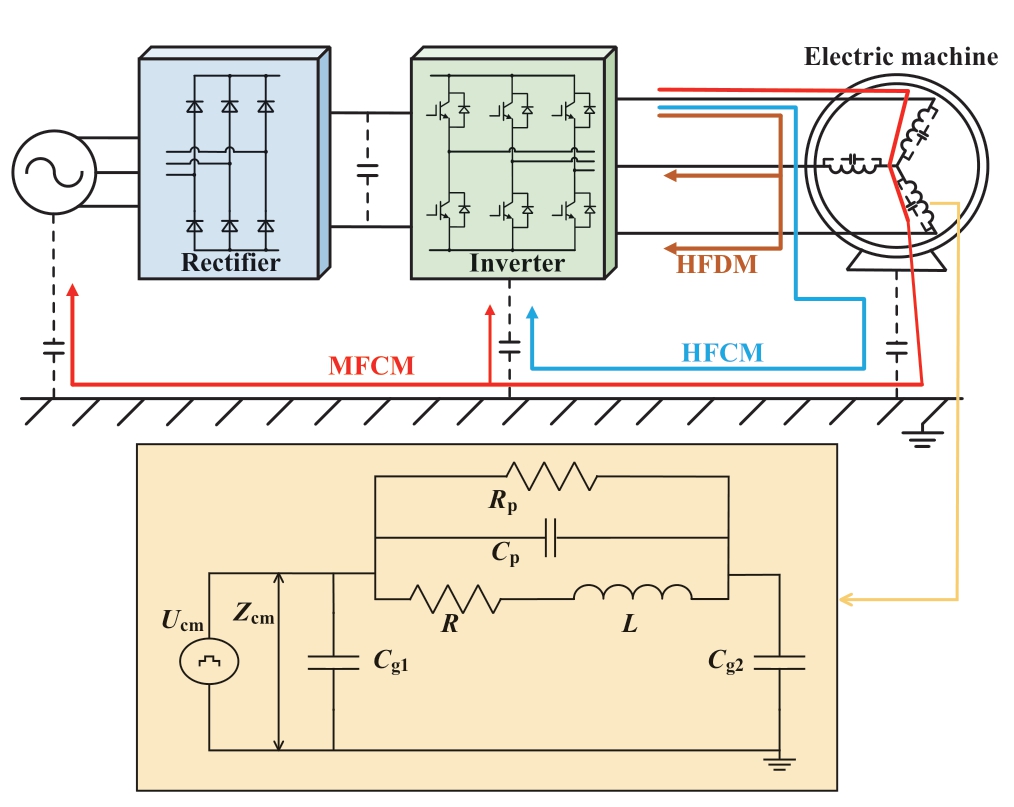
Fig.1 Path diagrams of three primary HF oscillatory modes of switching currents and simplified HFCM equivalent circuit of an electric machine
Considering that the capacitive values of the internal parasitic capacitors within the winding exceed those of the terminal parasitic capacitors,only the relatively lowfrequency MFCM current can reflect the state of the turn insulation via the parasitic parameter associated with turn insulation in the electric machine winding.
The HFCM equivalent circuit of the electric machine is shown in Fig.1 [30],where Cp is the turn capacitance of the stator winding,Rp is the HF eddy current loss resistance.The sum of Cg1 and Cg2 is the stray capacitance among the stator winding and the metallic core,L represent the equivalent inductance of the stator winding,R represent the equivalent resistance.Depending on the construction of the machine,Cp is primarily determined by the turn insulation.Zcm denotes the common-mode impedance of the electrical machine,Zcm is derived as follows:

According to Eq.(2),Zcm has two natural resonance frequencies: Fs and Fp.As shown in Fig.2,the series and parallel resonance points are denoted by Fs and Fp,in that order,as shown in Eq.(3) and (4): as the turn insulation gradually deteriorates,Cp will also change accordingly,the result is a change in impedance characteristics.In[22],the frequency region Fsen around Fp exhibits a greater responsiveness to changes in Cp.
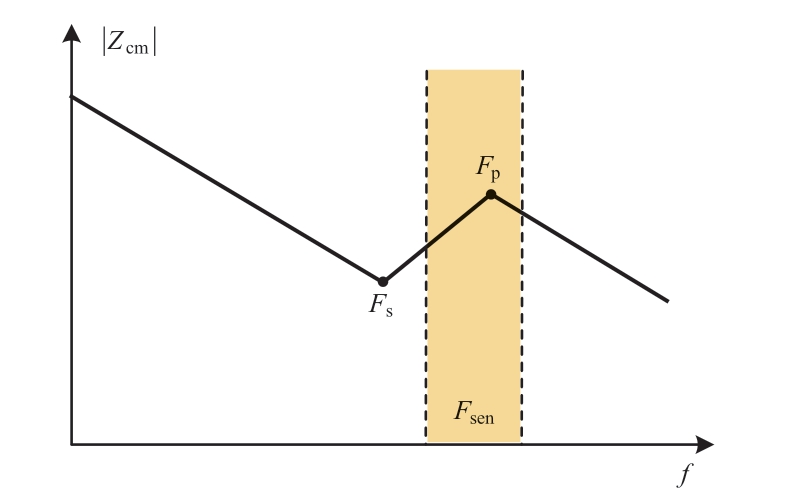
Fig.2 Typical common-mode impedance profile of an electric machine
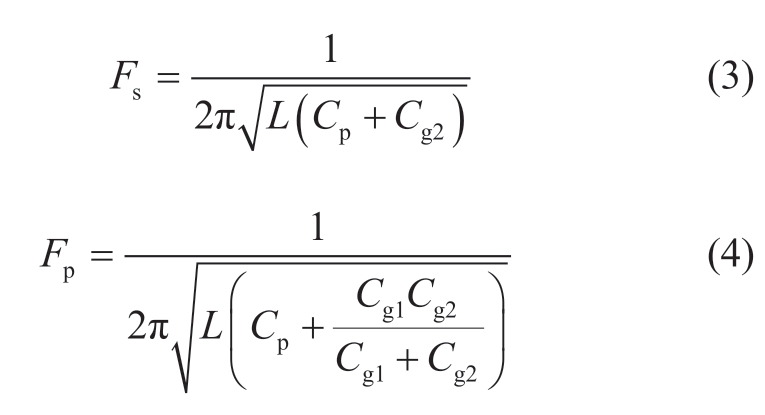
2 FrFT-Mel method for turn insulation monitoring
2.1 FrFT
FrFT can be regarded as a generalized iteration of the traditional fast Fourier transform (FFT).FrFT exemplifies a sequence of transformations from the time domain to an intermediate region between the time and frequency domains,referred to as the fractional domain [31].Fig.3 portrays FrFT as an α signal rotated counterclockwise by an angle alpha from the timeline to the u-axis.Essentially,FrFT constitutes a method of time-frequency analysis that allows a signal to display all the characteristics spanning the temporal to the spectral domains within the fractional domain U.The formula for FrFT is as follows:
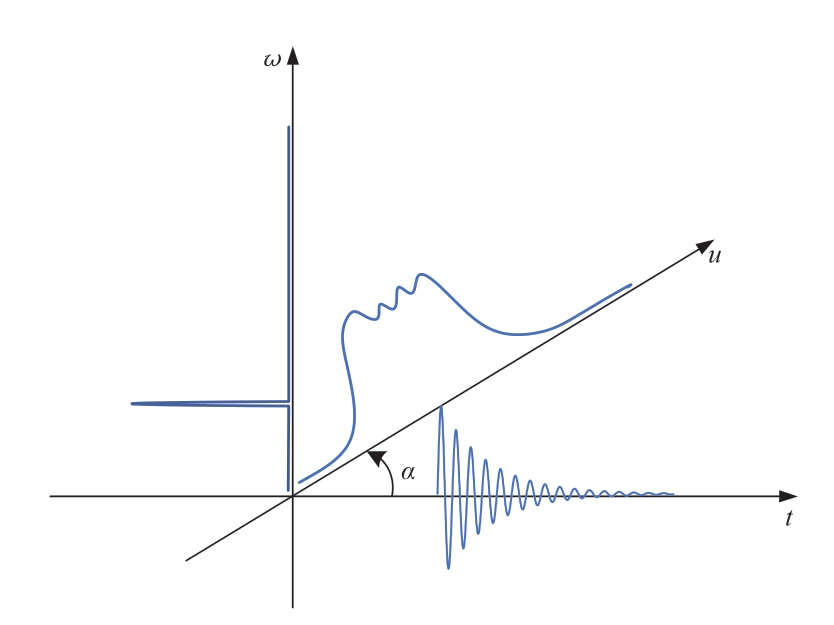
Fig.3 Time,frequency,and fractional domain of switching oscillation current
where the core function Kα(t,u) of FrFT is given as follows:

where α=πp /2 represents angular displacement in FrFT,with p denoting the order,indicating that the rotation angle of the transformation domain relative to the time axis is a fractional multiple of 90°,where u is the fractional-order frequency [32].
As shown in Eq.(6),the FrFT transformation demonstrates periodicity and symmetry upon reflection from the signal image.Consequently,this study focuses on the transformation order where pϵ [0,1].As illustrated in Fig.3,FrFT represents the time domain for p=0,whereas for p=1,it becomes analogous to the traditional Fourier transform.
In this study,FrFT was applied to the raw switching oscillation current.By modulating p,the signal within the fractional domain reveals numerous features that are absent in the time and frequency domains.These features play a crucial role in accurately differentiating the degree of turn insulation degradation,thereby enhancing the sensitivity of the state perception.
2.2 Mel filter
The Mel scale has been broadly applied across many speech-processing applications,typically as Mel-frequency cepstral coefficients (MFCCs).A set of triangular filters was used to apply the Mel-frequency transformation to a given speech spectrum [33],as depicted in Fig.4.
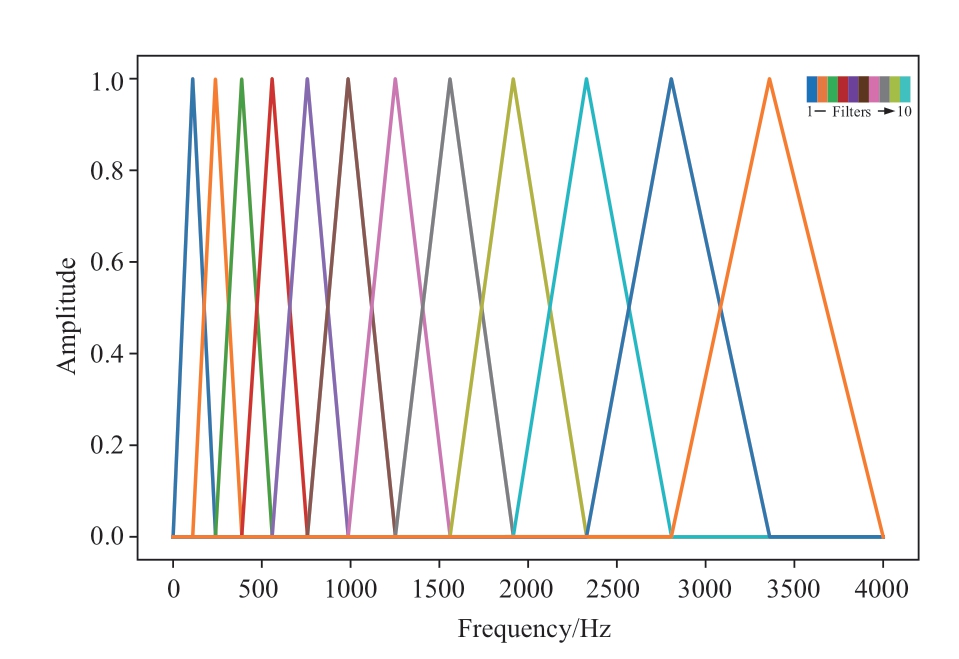
Fig.4 Distribution of a conventional Mel filter bank
The Mel amplitude of the filter increased more rapidly at lower frequencies compared to the HF band.The mapping of the Mel frequency unfolds as follows [34]:
As detailed in Section 1.2,the degradation characteristics of turn insulation were predominantly concentrated in the Fsen region.The traditional Mel filter primarily focuses on signal filtering within the 0-4 kHz band.Therefore,the traditional Mel filter requires an upgrade to align with the characteristics of turn insulation degradation.Features can be extracted effectively and data volume can be reduced by reconfiguring the feature regions from the low-frequency band to the Fsen region and subsequently from the Fsen region to the bilateral frequency band.Mel-frequency mapping exhibited the highest slope function at the characteristic frequency,and the slope exhibited as it approached the characteristic frequency.Consequently,a novel Mel filter bank was designed,as shown in Fig.5.
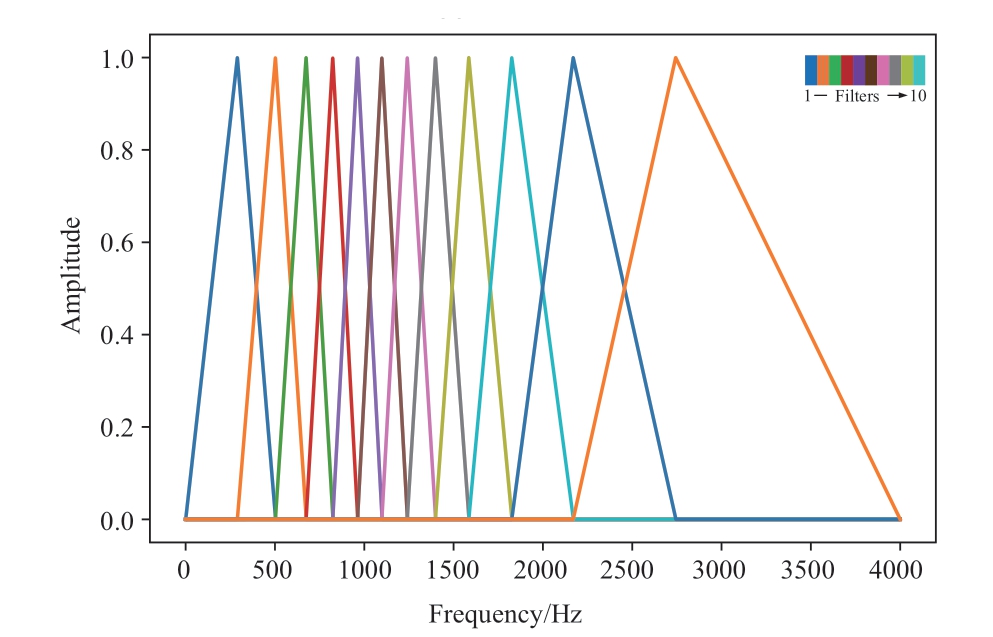
Fig.5 Distribution of an improved Mel filter bank
The novel Mel frequency mapping unfolds as follows:
where f0 is the center region of the extracted features.As mentioned in Section 1.2,the frequency band around the parallel resonance point Fp is more sensitive to changes in the turn insulation;therefore,in this study,f0 was chosen to be equal to Fp.m is the amplification factor,S change of the slope of the control mapping function,and D denotes the offset [35].
Recognizing the impact of some HF current signals on the extraction of the turn insulation degradation characteristics,a “core region” within the improved Mel filter was established.Based on f0,the core region was set to span a range exceeding Fsen,ensuring that most features were encapsulated within the core region.No filter bank was allocated to other areas,effectively filtering stray HF signals.The amplitude of the filter was amplified by a factor of two to underscore the characteristics of the concentrated region [35].In summary,the revised Mel filter offers more efficient feature extraction and reduced data size.
2.3 State perception system and workflows
A systematic illustration of the process for inverter-fed machine turn insulation perception is shown in Fig.6.

Fig.6 Schematic diagram of the procedure for inverter-fed machine turn insulation state sensing system
The specific process unfolds as follows:
1) Signal acquisition: The HF current sensor measures the HF switching oscillation current.The acquired signal is segmented into a single oscillation configuration.
2) Signal processing: The FrFT-Mel algorithm extracts features from a single oscillation,discerning the characteristics of turn insulation degradation.
3) Status evaluation: The MAE is used as the evaluation index and is calculated as follows [36]:
where n represents the total sample count, denotes the reference dataset,and yi is the error dataset.
denotes the reference dataset,and yi is the error dataset.
In this study,the reference data  relate to intact status of the turn insulation,and the different degradation states of the turn insulation serve as the error data yi.The MAE value is then computed to evaluate the extent of turn insulation degradation.
relate to intact status of the turn insulation,and the different degradation states of the turn insulation serve as the error data yi.The MAE value is then computed to evaluate the extent of turn insulation degradation.
3 Experimental study
3.1 Experimental setup
First,design experiments to verify the feasibility and effectiveness of the FrFT-Mel method.The arrangement of the experimental setup is depicted in Fig.7.
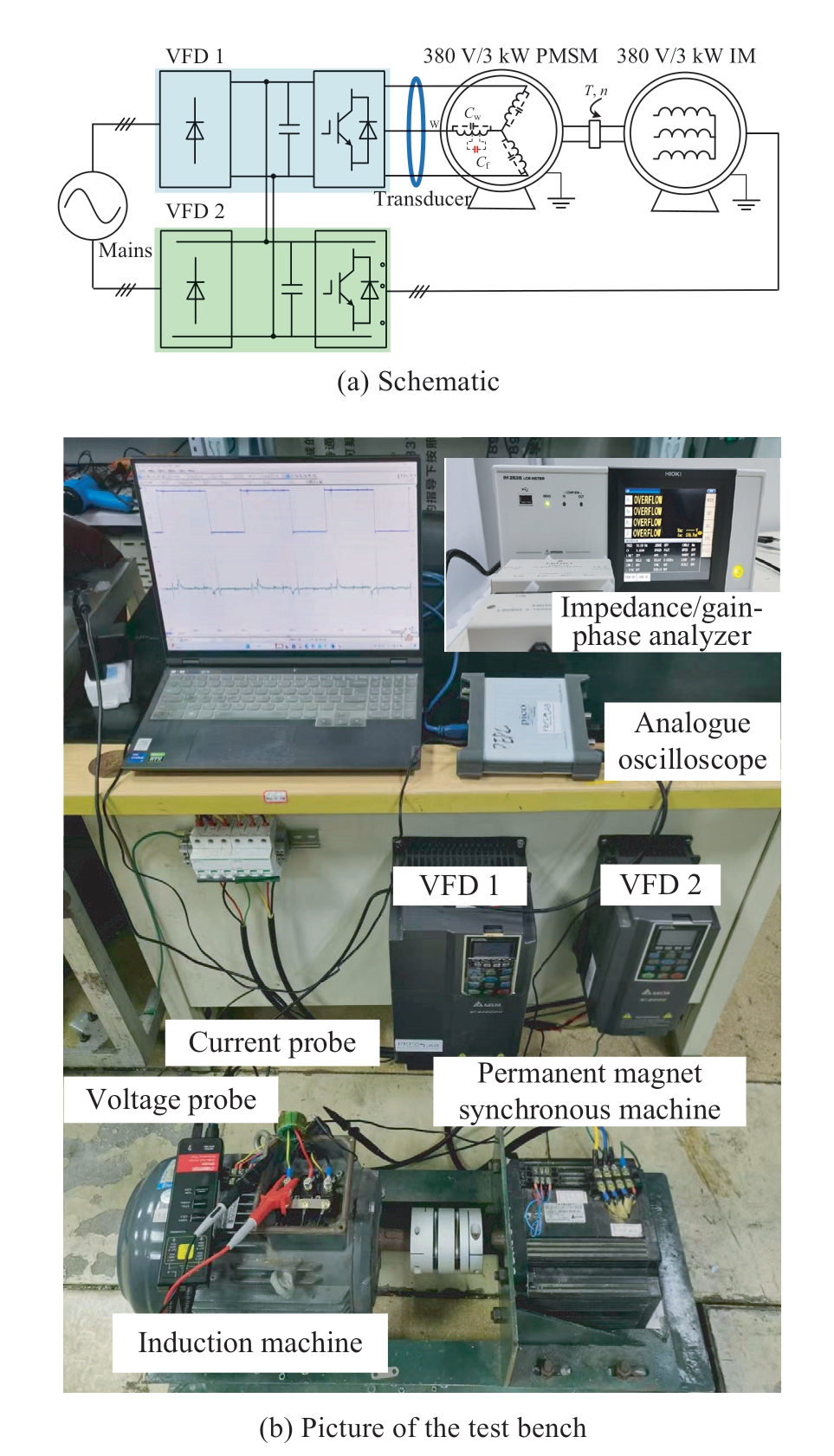
Fig.7 Setup of inverter-fed machine turn insulation state perception test bench
The tested machine was a three-phase 380 V/3 kW PMSM with a rated current of 7.5 A.The load machine corresponded to a three-phase,380 V/3 kW induction machine (IM).The key specifications of the PMSM are presented in Table 1.Two variable-frequency drives (VFD1 and VFD2) were used to control two electrical machines across different rotational speed and load conditions.This functionality permits the testing of PMSM under diverse pre-set conditions,encompassing fluctuating current and velocity.Through linking the DC buses of the two VFDs in parallel,the active power flow during the experiments is primarily divided among the buses.This setup provides considerable advantages for laboratories dealing with capacity constraints.
Table 1 Main parameters of PMSM
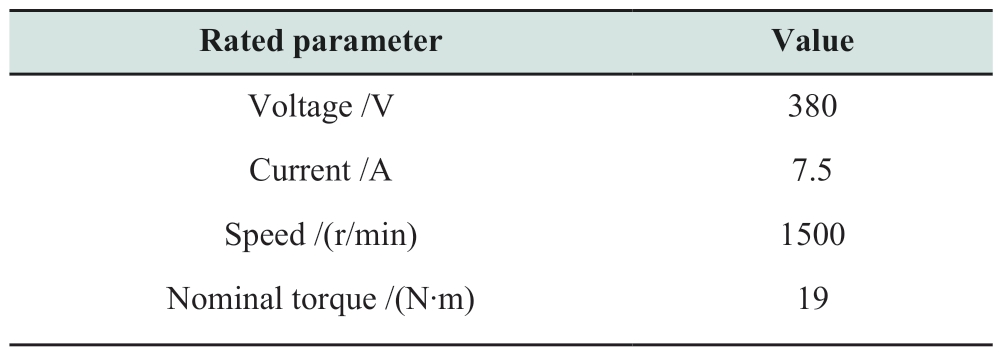
The voltage probe was a DP6150A HF voltage probe(1500 V/100 MHz),the current probe was a CP8030B HF current probe (30 A/50 MHz).Impedance analyzers are used to measure the common mode impedance values of electric machine.
The electric machine is insulated with a polyesterimide.The degradation of the insulation results in a relative capacitance increases between 20%-50% [37].To simulate the early insulation degradation that may arise from local weaknesses in the turn insulation of an electric machine winding,a compact capacitor was linked side by side between the two winding taps during the experiment.The turn capacitance of the electric machine winding Cp was approximately 625.8 pF.For this experiment,two external tested taps were led out from a W-phase winding coil of the PMSM stator,where a parallel capacitor Cf of 0.1nF-1nF was used to simulate the turn insulation degradation.The choice of Cf for the experiments is listed in Table 2.As illustrated in Fig.8,the common-mode impedance measurement of the inverter-fed machine shows thatthe spectrum spans of the parallel resonance point Fp is approximately 400 kHz.
Table 2 Extracted parameters of the PMSM with different external Cf

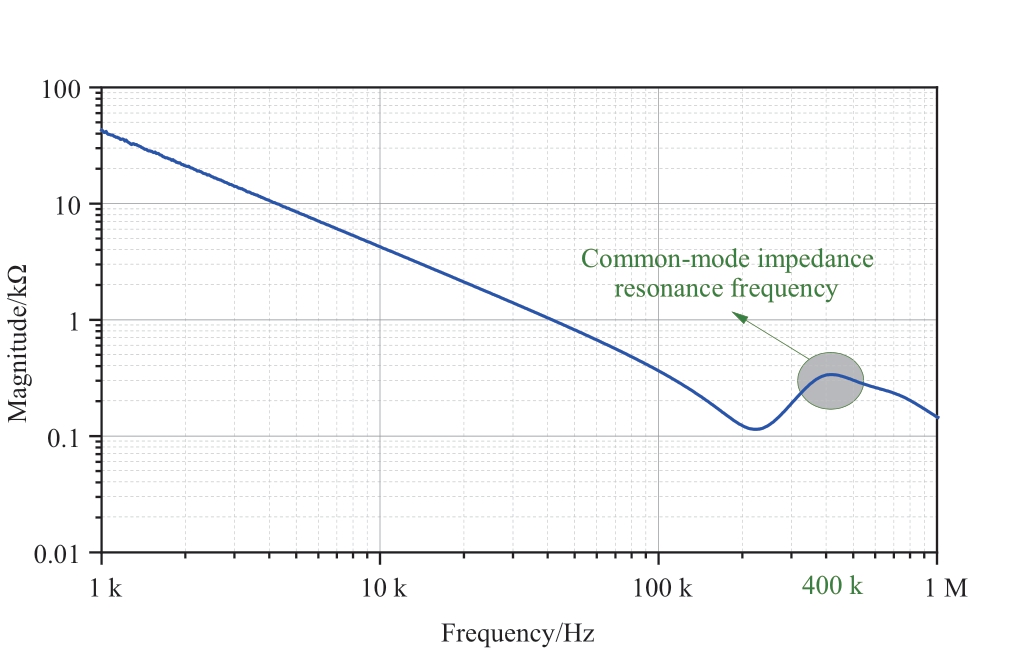
Fig.8 Measured common-mode impedance curve of the tested PMSM
3.2 Experimental results of the proposed FrFTMel method
The PWM voltage and switching oscillator current waveforms during normal operation of the inverter-fed machine are shown in Fig.9.The oscillation position was identified by relying on the maximum magnitude of the switching oscillation current.This facilitates the division of the sampled time-series signal into several distinct samples,each corresponding to an individual oscillation unit.Each segment spanned 10 μs and contains 1000 sampling points.Two hundred samples from each insulation state were used as the data samples.
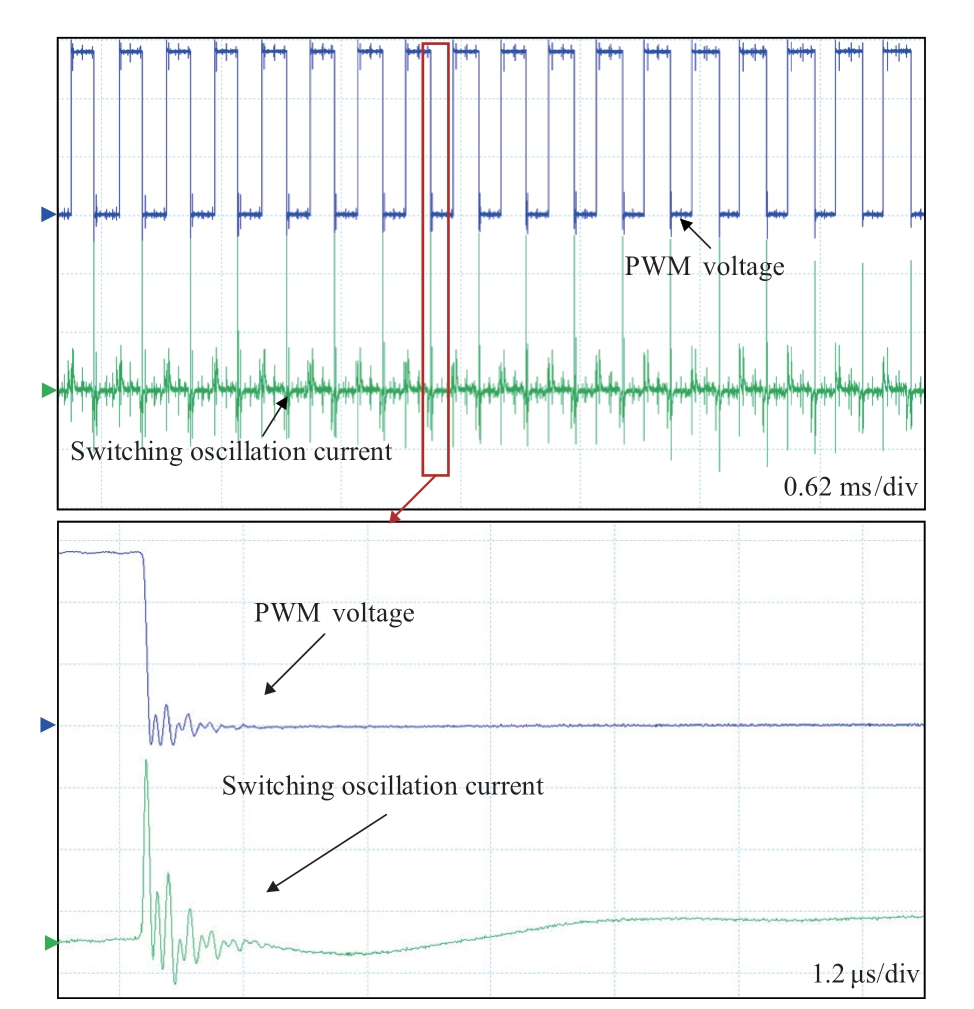
Fig.9 Waveform of the PMSM during normal operation(PWM voltage 200 V/div,Switching oscillation current 1 A/div)
In this study,the FrFT-Mel algorithm was applied to the experimental data using Python.The switching oscillation current displays several unique features across the timefrequency landscape of the FrFT spectrum,as shown in Fig.10.The characteristics vary with the change in order p.Therefore,finding the optimal order to maximize the resolution of turn insulation degradation is crucial.As shown in Fig.11,the MAE value peaks at p=0.88,indicating the greatest amplitude of change in this order.A better representation of the degree of turn insulation degradation was achieved.
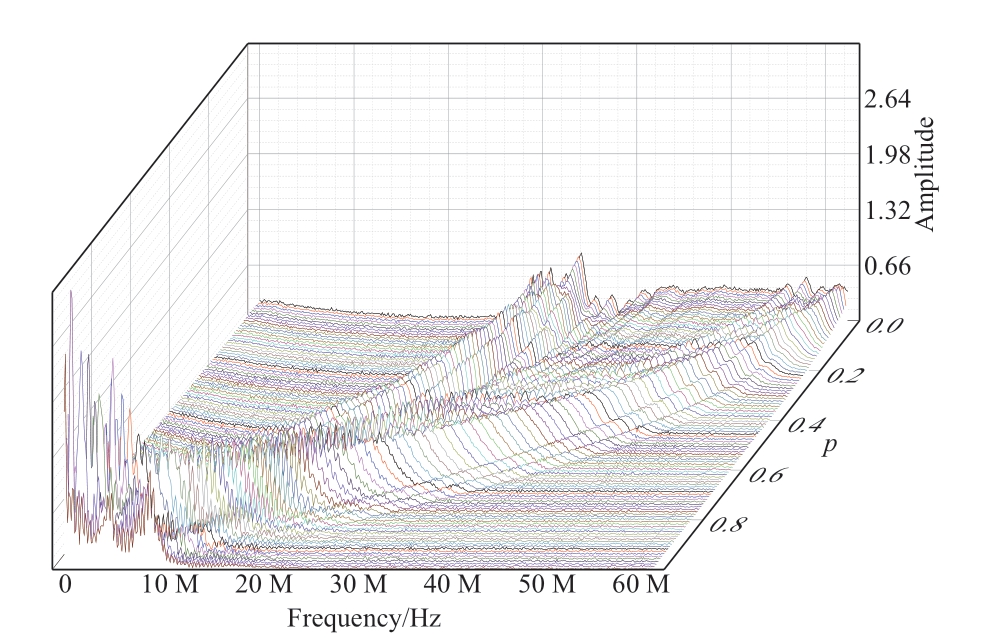
Fig.10 Fractional Fourier spectrum of single switch oscillates
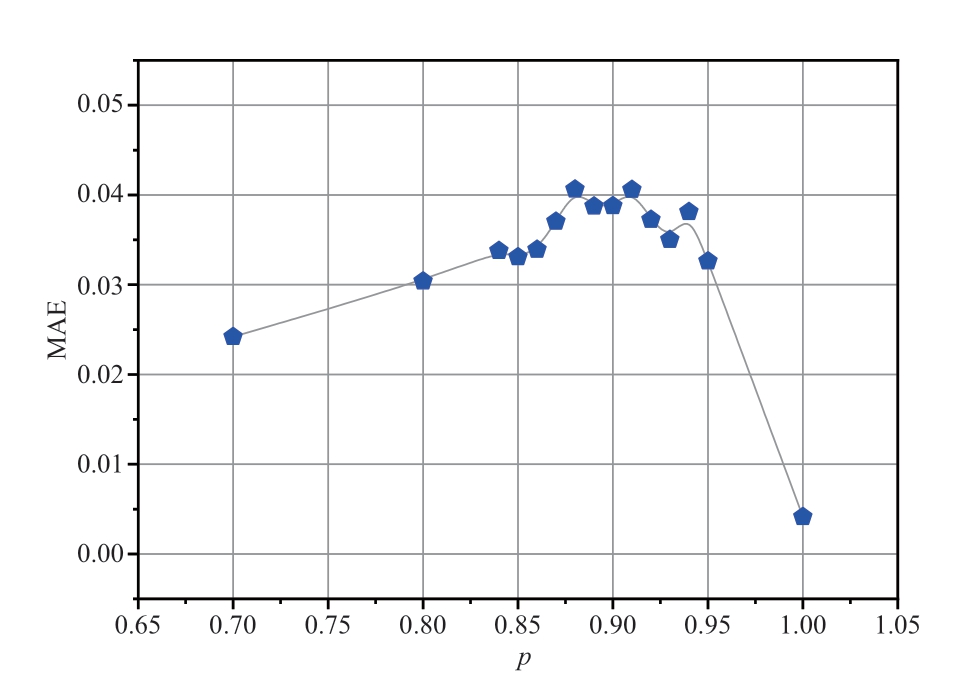
Fig.11 Optimal fractional order analysis
Following Section 3.1,parallel resonance point Fb better approximately 400 kHz.Therefore,in the improved Mel filter,f0 better set to 400 kHz,with 0-800 kHz selected as the core region to encompass most of the turn insulation state perception features.The design of the improved Mel filter is shown in Fig.12.
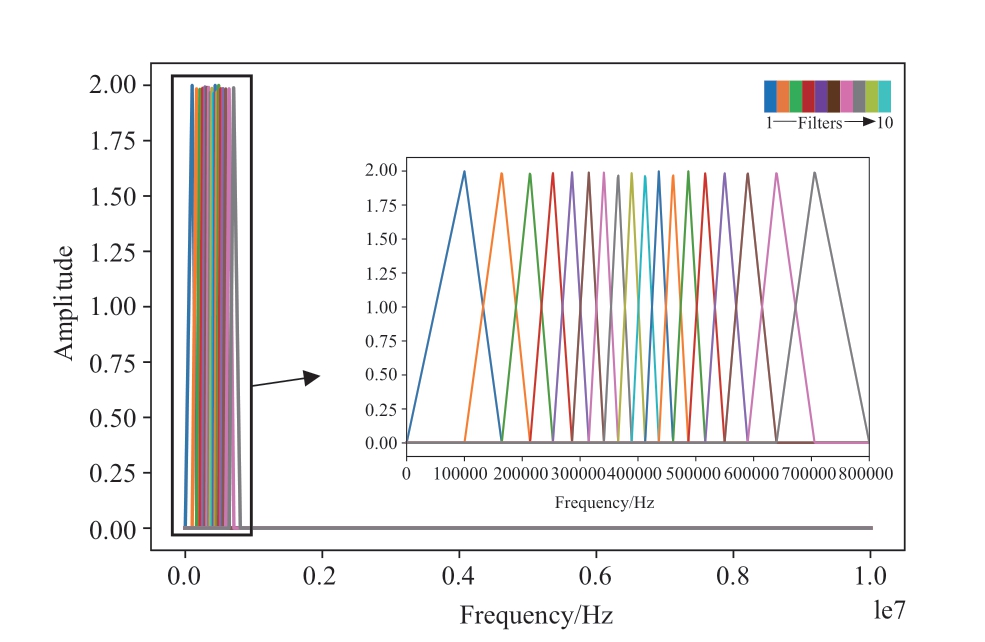
Fig.12 Improved Mel filter group distribution diagram
The results of the switching oscillation current signal filtered using the improved Mel filter are shown in Fig.13.The HF oscillation appeared to be attenuated,the characteristics of the frequency band became more evident in the current.
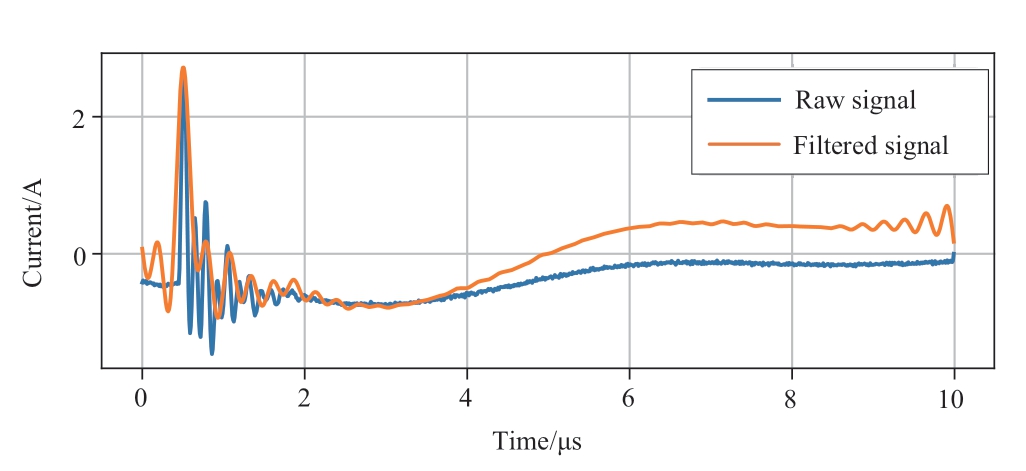
Fig.13 Improved Mel filter filtering effect diagram
Subtle changes marked the degradation of turn insulation.The fluctuations in the current,reflecting the degradation of the turn insulation,were also relatively minor,as shown in Fig.14 (a).However,Fig.14 (b)presents the results after the FrFT-Mel processing,highlighting that the signal waveform changes were considerably more significant than the switching oscillation current.This change makes the sensing of the turn insulation degradation more sensitive.This confirms that the FrFTMel method can enhance the sensitivity of perceiving the state of the turn insulation degradation.
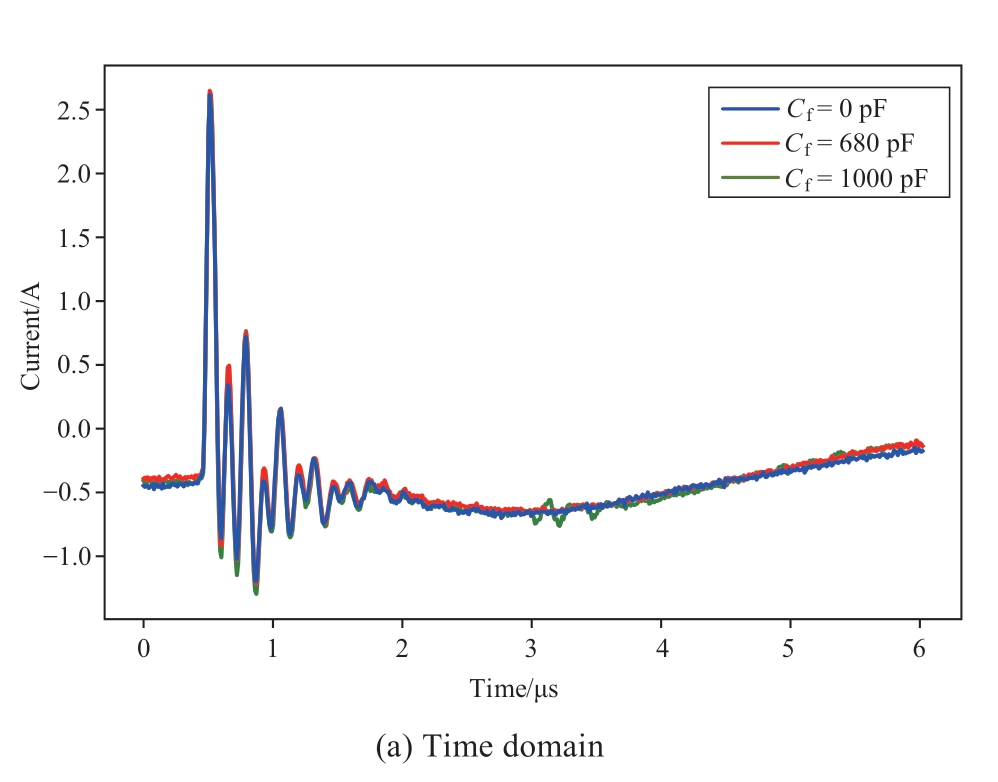
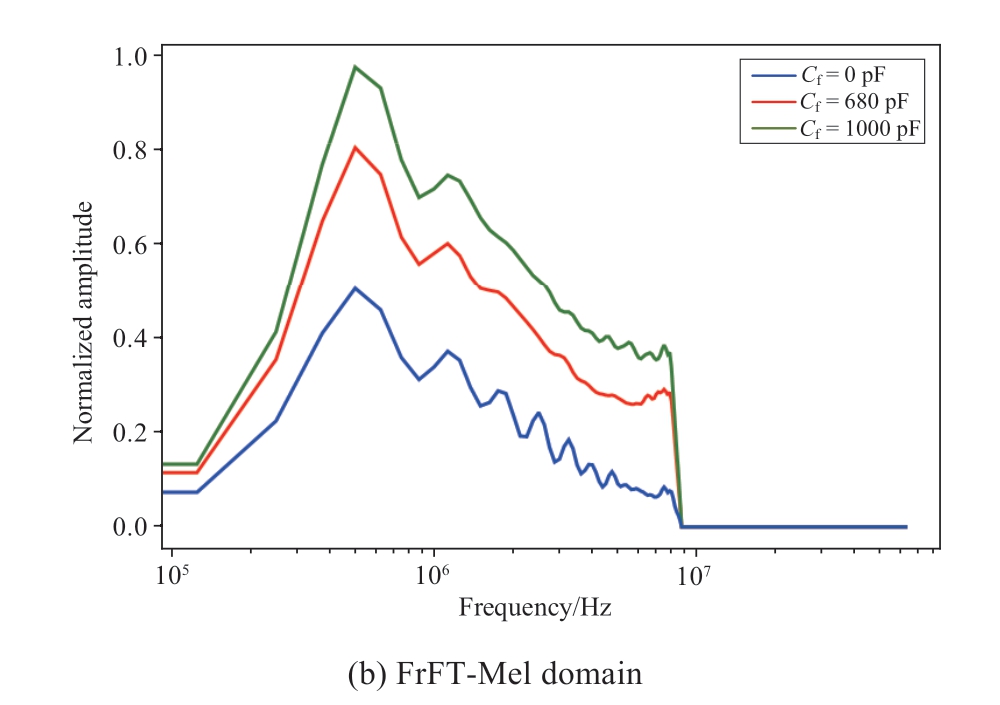
Fig.14 Comparison of switching oscillation current across various degradation states
3.3 Performance evaluation
MAE to quantitatively evaluate the deterioration state of turn insulation.In these tests,Cf=0 pF was selected as the benchmark data  ,whereas the other Cf values were considered as error data yi.The results of the MAE calculations are presented in Fig.15.As Cf increased progressively,MAE also exhibited a corresponding upward trend.This trend confirms that MAE is an effective metric for assessing the degradation of turn insulation.
,whereas the other Cf values were considered as error data yi.The results of the MAE calculations are presented in Fig.15.As Cf increased progressively,MAE also exhibited a corresponding upward trend.This trend confirms that MAE is an effective metric for assessing the degradation of turn insulation.
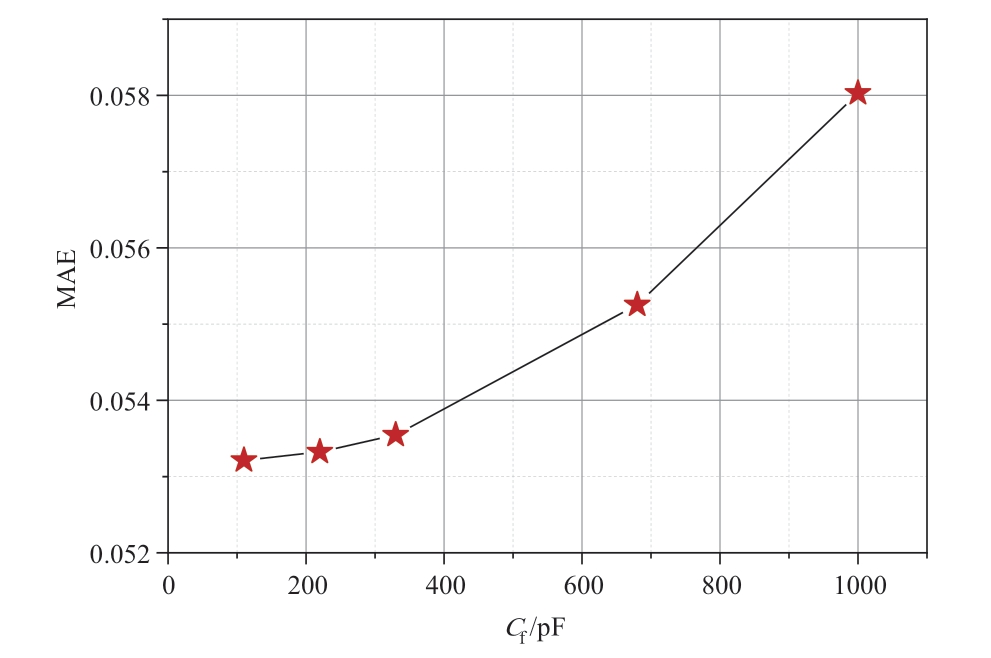
Fig.15 The extracted MAE at different Cf
A change rate Δp index is constructed and defined in Eq.(10) to evaluate the performance of the FrFT-Mel method.

where ![]() is the average value of the evaluation index MAE and
is the average value of the evaluation index MAE and ![]() is the average value of MAE under different Cf conditions.Considering the feature change in turn insulation degradation is very small,Cf=100 pF is used as the change rate benchmark,that is
is the average value of MAE under different Cf conditions.Considering the feature change in turn insulation degradation is very small,Cf=100 pF is used as the change rate benchmark,that is ![]()
As shown in Fig.14(a),directly distinguishing turn insulation degradation in the time domain is challenging.However,compared to the traditional FFT method,the FrFT-Mel approach successfully extracts more degradation features,enhancing the discernment of the turn insulation deterioration states.As depicted in Fig.16,the proposed FrFT-Mel method substantially improves the Δp value compared to the FFT method.As indicated in Table 3,the Δp value for FFT is a mere 0.41% when Cf=220 pF.This value increased to 3.16% following processing using the FrFT-Mel method,signifying an improvement of more than seven-fold compared to the FFT method.Even when Cf=680 pF,the Δp value for FFT is only 2.55%,which is still lower than the Δp value obtained from the FrFT-Mel method at Cf=220 pF.
Table 3 Sensitivity comparison of different methods to the change of turn insulation state
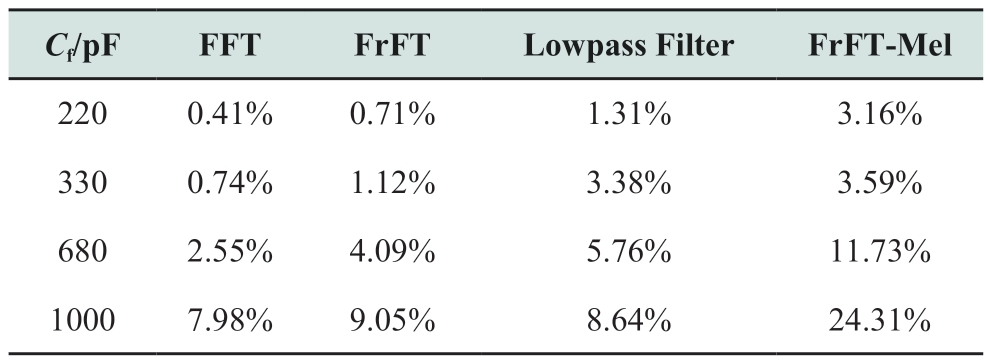
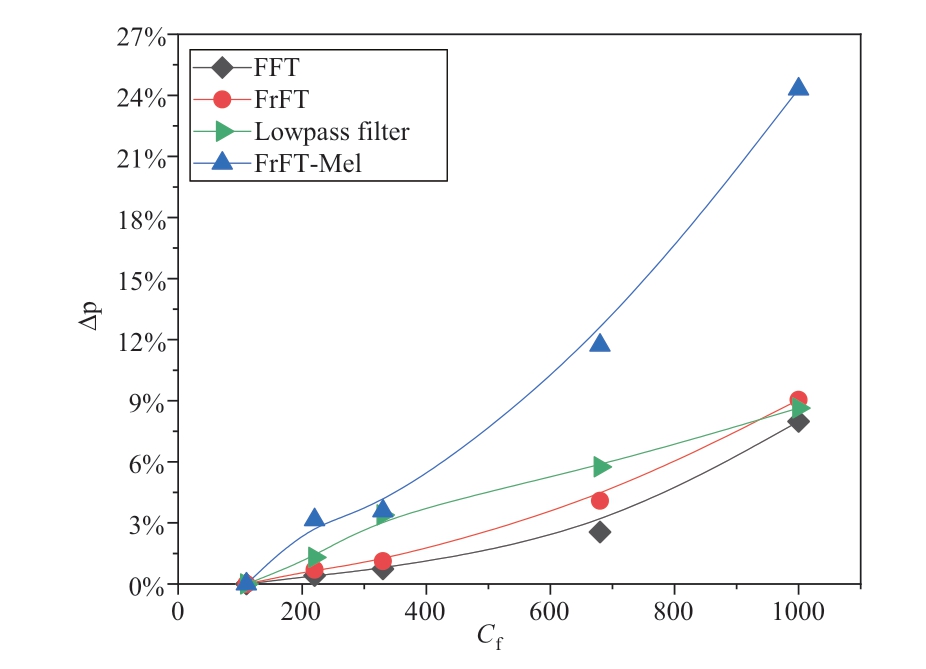
Fig.16 Sensitivity comparison results under different methods
Additionally,in contrast to other signal processing techniques,such as FrFT and low-pass filters,the FrFTMel method demonstrates varying degrees of enhancement across diverse Cf conditions.This analysis substantiates that the FrFT-Mel method considerably amplifies the sensitivity of detecting turn insulation degradation states.This is particularly pronounced in the early stages of degradation when the effectiveness of the method is most noticeable.
4 Conclusions
Online monitoring of stator turn insulation conditions in inverter-fed machines is essential to prevent abrupt and catastrophic failures.This study proposes a new approach to enhance the perception sensitivity of stator-turn insulation degradation.The verification process was conducted through a series of experiments,leading to the following conclusions:
1) FrFT can reveal more intricate features of the turn insulation deterioration in inverter-fed machines,increasing the detection sensitivity.
2) A novel Mel filter was developed,leveraging the characteristic common-mode impedance resonance point of inverter-fed machines.This filter not only extracts features more effectively but also reduces computational complexity.
3) A stator turn insulation state perception method based on FrFT-Mel was proposed.The experimental results confirm that this method markedly enhances the sensitivity of the insulation degradation detection.Notably,the sensitivity during the early stages of degradation improved by a factor of seven.
It is anticipated that the introduced approach will improve the efficacy of early-stage online turn insulation degradation detection in inverter-fed machines for uses in sectors like high-speed railways and electric vehicles.Subsequent efforts will primarily concentrate on enhancing the efficiency of determining the order of the FrFT,considering the introduction of deep learning techniques to further improve the sensing accuracy and reduce computational costs.
Acknowledgments
This work was supported in part by the National Natural Science Foundation of China under Grant 51907116,in part sponsored by Natural Science Foundation of Shanghai 22ZR1425400 and sponsored by Shanghai Rising-Star Program 23QA1404000.
Declaration of competing interest
We declare that we have no conflict of interest.
References
[1] Lu Z X,Li H,Qiao Y (2021) Analysis of the morphological evolution of the high proportion of renewable energy power system from the perspective of flexible balance.Journal of Global Energy Interconnection,4(1): 12-18(in Chinese)
[2] Fang B M,Qiu W Q,Wang M C,et al.(2022) Evaluation index system of shared energy storage market towards renewable energy accommodation scenario: a China’s Qinghai province context.Global Energy Interconnection,5(1): 77-95
[3] Thomas V,Kumaravel S,Ashok S (2021) Fuzzy controllerbased self-adaptive virtual synchronous machine for microgrid application.IEEE Transactions on Energy Conversion,36(3):2427-2437
[4] Li J Q,Liu J,Chen Y T (2022) A fault warning for inter-turn short circuit of excitation winding of synchronous generator based on GRU-CNN.Global Energy Interconnection,5(2): 236-248
[5] Li H,Liu J Y,Xiang D W,et al.(2024) Feature extraction and decoupling of line-end coil insulation for inverter-fed machine using high-frequency differential mode switching oscillation.Proceedings of the CSEE,44(4): 1608-1617(in Chinese)
[6] Castro Palavicino P,Sarlioglu B (2023) Estimation of position and shorted turns percentage of an inter-turn short circuit in interior permanent magnet synchronous machines based on a current observer and stationary reference frame tracking.IEEE Transactions on Industry Applications,59(4): 4066-4075
[7] Park C,Lee H,Zapico M O,et al.(2023) Automated testing for early identification of PD in the stator insulation of low voltage VFD motors.IEEE Transactions on Industry Applications,59(4):3910-3919
[8] Niu G,Dong X,Chen Y J (2023) Motor fault diagnostics based on current signatures: A review.IEEE Transactions on Instrumentation and Measurement,72: 3520919
[9] Stone G C,Sedding H G,Chan C (2018) Experience with online partial-discharge measurement in high-voltage inverter-fed motors.IEEE Transactions on Industry Applications,54(1): 866-872
[10] Jensen W R,Strangas E G,Foster S N (2018) A method for online stator insulation prognosis for inverter-driven machines.IEEE Transactions on Industry Applications,54(6): 5897-5906
[11] Stone G C,Stranges M K W,Dunn D G (2016) Common questions on partial discharge testing: A review of recent developments in IEEE and IEC standards for offline and online testing of motor and generator stator windings.IEEE Industry Applications Magazine,22(1): 14-19
[12] Younsi K,Neti P,Shah M,et al.(2010) On-line capacitance and dissipation factor monitoring of AC stator insulation.IEEE Transactions on Dielectrics and Electrical Insulation,17(5): 1441-1452
[13] Zhang P J,Younsi K,Neti P (2015) A novel online stator groundwall insulation monitoring scheme for inverter-fed AC motors.IEEE Transactions on Industry Applications,51(3): 2201-2207
[14] Dymond J H,Stranges M K W,Stranges N (2005) The effect of surge testing on the voltage endurance life of stator coils.IEEE Transactions on Industry Applications,41(1): 120-126
[15] Zheng D Y,Zhang P J (2019) A review of fault diagnosis and online condition monitoring of stator insulation in AC electrical machine.Proceedings of the CSEE,39(2): 395-406+637(in Chinese)
[16] Perisse F,Werynski P,Roger D (2007) A new method for AC machine turn insulation diagnostic based on high frequency resonances.IEEE Transactions on Dielectrics and Electrical Insulation,14(5): 1308-1315
[17] Neti P,Grubic S (2017) Online broadband insulation spectroscopy of induction machines using signal injection.IEEE Transactions on Industry Applications,53(2): 1054-1062
[18] Nussbaumer P,Vogelsberger M A,Wolbank T M (2015)Induction machine insulation health state monitoring based on online switching transient exploitation.IEEE Transactions on Industrial Electronics,62(3): 1835-1845
[19] Cao S R,Niu F,Huang X Y,et al.(2020) Time-frequency characteristics research of common mode current in PWM motor system.IEEE Transactions on Power Electronics,35(2): 1450-1458
[20] Nussbaumer P,Vogelsberger M A,Wolbank T M (2015)Induction machine insulation health state monitoring based on online switching transient exploitation.IEEE Transactions on Industrial Electronics,62(3): 1835-1845
[21] Li H,Zhao M,Xiang D W,et al.(2020) On-line monitoring of incipient turn insulation deterioration of servo motor using switching transient frequency response.Proceedings of the CSEE,40(10): 3359-3367(in Chinese)
[22] Xiang D W,Li H,Yan H,et al.(2021) Online monitoring of incipient turn insulation degradation for inverter-fed machine using sensitive tail component in PWM switching oscillations.IEEE Transactions on Power Electronics,36(8): 8730-8742
[23] He S F,Tian W,Zhang J M,et al.(2019) A high efficient approach for power disturbance waveform compression in the view of Heisenberg uncertainty.IEEE Transactions on Industrial Informatics,15(5): 2580-2591
[24] Şahinuç F,Koç A (1916) Fractional Fourier transform meets transformer encoder.IEEE Signal Processing Letters,29: 2258-2262
[25] Xie C X,Zhang L M,Zhong Z G (2021) Quasi-LFM radar waveform recognition based on fractional Fourier transform and time-frequency analysis.Journal of Systems Engineering and Electronics,32(5): 1130-1142
[26] Gandhi A,Corrigan T,Parsa L (2011) Recent advances in modeling and online detection of stator interturn faults in electrical motors.IEEE Transactions on Industrial Electronics,58(5): 1564-1575
[27] Leuzzi R,Monopoli V G,Rovere L,et al.(2019) Analysis and detection of electrical aging effects on high-speed motor insulation.IEEE Transactions on Industry Applications,55(6):6018-6025
[28] Gyftakis K N,Sumislawska M,Kavanagh D F,et al.(2016)Dielectric characteristics of electric vehicle traction motor winding insulation under thermal aging.IEEE Transactions on Industry Applications,52(2): 1398-1404
[29] Perisse F,Mercier D,Lefevre E,et al.(2009) Robust diagnostics of stator insulation based on high frequency resonances measurements.IEEE Transactions on Dielectrics and Electrical Insulation,16(5): 1496-1502
[30] Zheng D Y,Lu G Y,Zhang P J (2021) A noninvasive interturn insulation condition monitoring method based on the commonmode impedance spectrum of inverter-fed machines.IEEE Transactions on Industry Applications,57(5): 4786-4795
[31] Li Z Y,Zhang X D,Yang Q,et al.(2021) Hybrid SAR-ISAR image formation via joint FrFT-WVD processing for BFSAR ship target high-resolution imaging.IEEE Transactions on Geoscience and Remote Sensing,60: 5215713
[32] Bi X W,Guo S L,Yang Y X,et al.(2022) Adaptive target extraction method in sea clutter based on fractional Fourier filtering.IEEE Transactions on Geoscience and Remote Sensing,60: 5115609
[33] Muralishankar R,Ghosh D,Gurugopinath S (2020) A novel modified mel-DCT filter bank structure with application to voice activity detection.IEEE Signal Processing Letters,27: 1240-1244
[34] Roy A,Satija U (2023) RDLINet: A novel lightweight inception network for respiratory disease classification using lung sounds.IEEE Transactions on Instrumentation and Measurement,72:4008813
[35] Wang Y,Sheng D J,Hu H Q,et al.(2022) A novel series arc fault detection method based on mel-frequency cepstral coefficients and fully connected neural network.IEEE Access,10: 97983-97994
[36] Zhu J S,Cui Y J,Zhang Y,et al.(2023) A slope-assisted back propagation method for bathymetric mapping.IEEE Transactions on Geoscience and Remote Sensing,61: 5406213
[37] Li H,Xiang D W,Yang X W,et al.(2019) Compressed sensing method for IGBT high-speed switching time on-line monitoring.IEEE Transactions on Industrial Electronics,66(4): 3185-3195

Scan for more details
Received:20 July 2023/Revised: 4 February 2024/Accepted:12 March 2024/Published: 25 April 2024
 Xing Lei
Xing Lei
leixingsh@163.com
Ruitian Fan
frt_9801@163.com
Tao Jia
jiatao@sgtc.sgcc.com.cn
Menglong Qin
qml0661@163.com
Hao Li
hlipower@shiep.edu.cn
Dawei Xiang
xdw_cqu@sina.com
2096-5117/© 2024 Global Energy Interconnection Development and Cooperation Organization.Production and hosting by Elsevier B.V.on behalf of KeAi Communications Co.,Ltd.This is an open access article under the CC BY-NC-ND license (http://creativecommons.org/licenses/by-nc-nd/4.0/).
Biographies

Ruitian Fan was born in Shandong,China,in 1998.He received the B.S.degree in electrical engineering from Qilu University of Technology,Shandong,China.Currently,he is studying for M.S.degree at the Shanghai University of Electric Power.His main research interest includes condition monitoring of electric machine insulation.

Xing Lei received M.S.degree at North China Electric Power University in 2006,and received Ph.D.degree at Shandong University in 2012.He is working in State Grid Shanghai Municipal Electric Power Company.His research interests include power system automation,equipment maintenance.
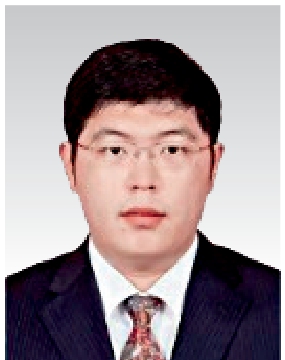
Tao Jia received M.S.degree at Shandong University in 2009.He is working in State Grid Technology College.His research interests include power system automation,substation operation and maintenance.

Menglong Qin received his B.S.degree in Electrical Engineering and Automation from Jiangsu University,Jiangsu,China,and is currently pursuing his M.S.degree at Shanghai University of Electric Power,Shanghai,China,where his main research focus is on condition assessment and inspection of power cables.
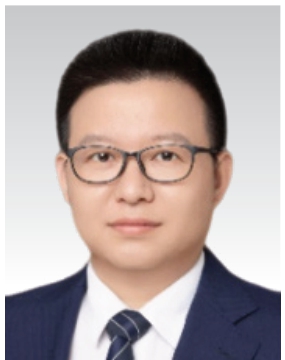
Hao Li received the Ph.D.degree in control science and engineering from Tongji University,Shanghai,China,in 2016.Currently,he is working as an Associate Professor at College of Electrical Engineering in Shanghai University of Electric Power,Shanghai,China.His main research interests include condition monitoring of power electronics system.

Dawei Xiang received the Ph.D.degree in electrical engineering from Chongqing University,Chongqing,China,in 2016.Currently,he is working as an Associate Professor in Tongji University of Electric Power,Shanghai,China.His main research interests include condition monitoring of power electronics system and electric machine control.
(Editor Yajun Zou)
